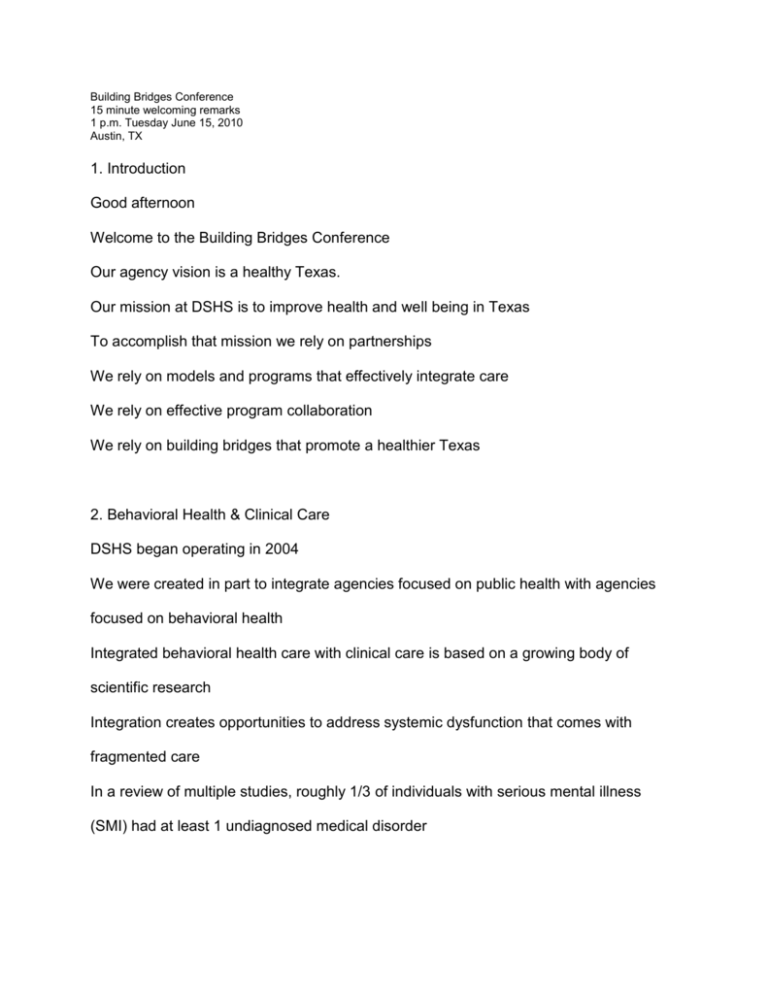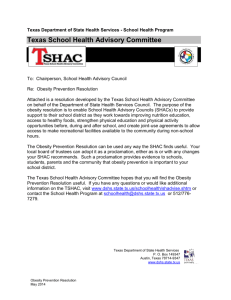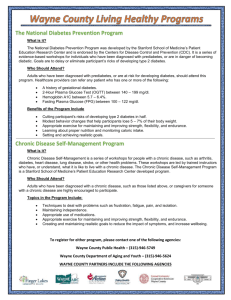DrLakey - Texas Department of State Health Services
advertisement

Building Bridges Conference 15 minute welcoming remarks 1 p.m. Tuesday June 15, 2010 Austin, TX 1. Introduction Good afternoon Welcome to the Building Bridges Conference Our agency vision is a healthy Texas. Our mission at DSHS is to improve health and well being in Texas To accomplish that mission we rely on partnerships We rely on models and programs that effectively integrate care We rely on effective program collaboration We rely on building bridges that promote a healthier Texas 2. Behavioral Health & Clinical Care DSHS began operating in 2004 We were created in part to integrate agencies focused on public health with agencies focused on behavioral health Integrated behavioral health care with clinical care is based on a growing body of scientific research Integration creates opportunities to address systemic dysfunction that comes with fragmented care In a review of multiple studies, roughly 1/3 of individuals with serious mental illness (SMI) had at least 1 undiagnosed medical disorder People with SMIs are often linked to poor diet, obesity, high smoking rates, & use of alcohol & drugs Also, some drugs used to treat SMI’s are linked to weight gain, onset of diabetes, Adults with SMIs have higher rates of chronic medical conditions, including hypertension, HIV/AIDS & diabetes, more multiple medical conditions, & higher premature mortality Despite a higher incidence of chronic medical disorders, adults with severe mental illness have worse access to care & the care they receive is lower quality care For example, individuals with schizophrenia have a 20% shorter life expectancy that the overall population Experts recommend MH providers work with primary care providers to perform physical health monitoring and behavioral health monitoring in primary care and other settings This approach is necessary to address comorbidities. 3. DSHS & Integrated Care: Our agency is involved in multiple initiatives whose purpose is to ensure that each person receives the comprehensive care they need These include: Mental Health Transformation (improved MH services across state agencies) Adolescent Mental Health Screening (screenings, referrals, treatment) Project Insight (SA screening in primary care settings) Youth Suicide Prevention Project (screening, referrals, interventions in 3 TX counties) Clinical Management for Behavioral Health Services (CMBHS) (information-sharing tools) Integrated disaster response (to ensure mental health services at disaster/shelter sites) Tobacco (combines PH model w substance abuse services for prevention/cessation) 4. DSHS efforts to link internal programs/initiatives re disease prevention/health promotion Initiatives to integrate care and implement program collaboration extend across multiple DSHS programs & divisions Some examples: Obesity Pooled funding from three different funding sources 1. New appropriations in last legislative sessions for obesity 2. funds from Title V– maternal child health block health program 3. funds from Border Health Rationale: In these three programs Obesity is a priority. Instead of each program going out with separate RFP’s they combined funds and created one RFP to have a greater impact and consistency across the agency in what we are asking communities to do. This also helped LHD’s by requiring that they apply for one RFP instead of multiple. Breast Feeding Collaborative strategic planning for breast feeding promotion because breast feeding is a shared priority It is essential to include all relevant programs in the planning process. However, WIC is taking lead in strategic planning. Looking at ways to collaborate not only in planning, but in funding DSHS staff and resources to support community initiatives. Effort will include Title V, as well as breast feeding strategies that prevention and preparedness is using for obesity prevention. School health program P&P handles contracts with the education service centers – (regional folks who support the schools) We pool funds from mental health and substance abuse, maternal and child health, diabetes, abstinence 3 different divisions and multiple programs are involved in these contracts Goal: to coordinate our priorities for training and technical assistance going out to school districts. We consider this a coordinated and comprehensive approach to working with schools on health issues Diabetes Council and Cardiovascular Council Pooled funding to go into a community health center project to improve standards of care- P&P monies Targeting community health centers Looking at the system as a whole to ultimately create improved systems of care for community health center. This will not only benefit those suffering from heart disease & diabetes but all conditions. 5. Unhealthy behaviors drive chronic disease rates The leading causes of death in Texas are heart disease, cancer and stroke. However, the CDC describes the 3 leading “actual” causes of death to be: 1. poor diet/lack of exercise. 2. tobacco use 3. immoderate use of alcohol Whatever chronic disease we might consider: heart disease & stroke, diabetes, many cancers—unhealthy behaviors drive chronic disease rates and account for 2/3 of all deaths in Texas. Any effective intervention in any Texas community that lowers smoking rates or significantly increases physical activity & healthy eating should, over time, lower chronic disease rate across the board. 6. Improving public health through program collaboration Texas already benefits from chronic disease program integration with outside partners We strive to efficiently use our staffs, our funds, our surveillance and our intervention efforts. Partnerships help us overcome constraints in funding and resources. However we recognize barriers and challenges as we work across programs, agencies and organizations to provide better care. Those barriers include: competition for funding, categorical funding, concerns about program or organizational identity, constituents, and program outcomes or achievements This conference will provide opportunities for us to learn how to overcome some of these barriers. Let me offer the following broad guidelines Program integration should help participants know what actions are being taken & why. Integration is a process that seeks consensus Consensus must be reached on both short and long-term goals. It is essential for partners to: respect each program’s identity preserve individual program expertise Sustain constituencies Maintain accountability to categorical program priorities Celebrate and replicate successful interventions while at the same time Encourage cooperation, coordination and collaboration Improved population health is the most important guiding principle for program integration How we work together to improve the health of common populations is our biggest challenge Clearly we must: Improve our programs’ ability to address diversity Reduce health disparities Be measurable Use evidence-based practices The shift in focus from risk factors and diseases to population-based chronic disease prevention is a difficult shift to navigate. It is difficult in part because we must maintain a focus on risk factors, disease treatment and disease research It is difficult because we must maximize the impact of investments across categorical programs It is difficult because we are developing and evaluating new models for chronic disease prevention We know our collaborative efforts must be community-based These efforts must focus more and more on the built environment William Roper, a former CDC director, described public health as “the intersection of science and politics’ We must effectively represent the scientific side of the conversation In a somewhat new and expanded role for public health, we must advocate “health in all policies and settings.” Policies in agriculture, education and transportation affect incidence rates of chronic diseases The availability and quality of parks and recreational facilities affects the impact of chronic diseases in our community As does the availability and affordability of fresh fruits and vegetables All this means that there are many emerging opportunities for us to work together, learn from each other, explore new approaches, and ultimately, create a healthier Texas through effective collaboration. Thank you for coming Enjoy the conference.







